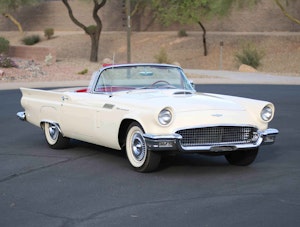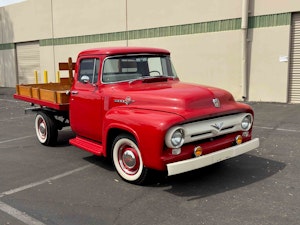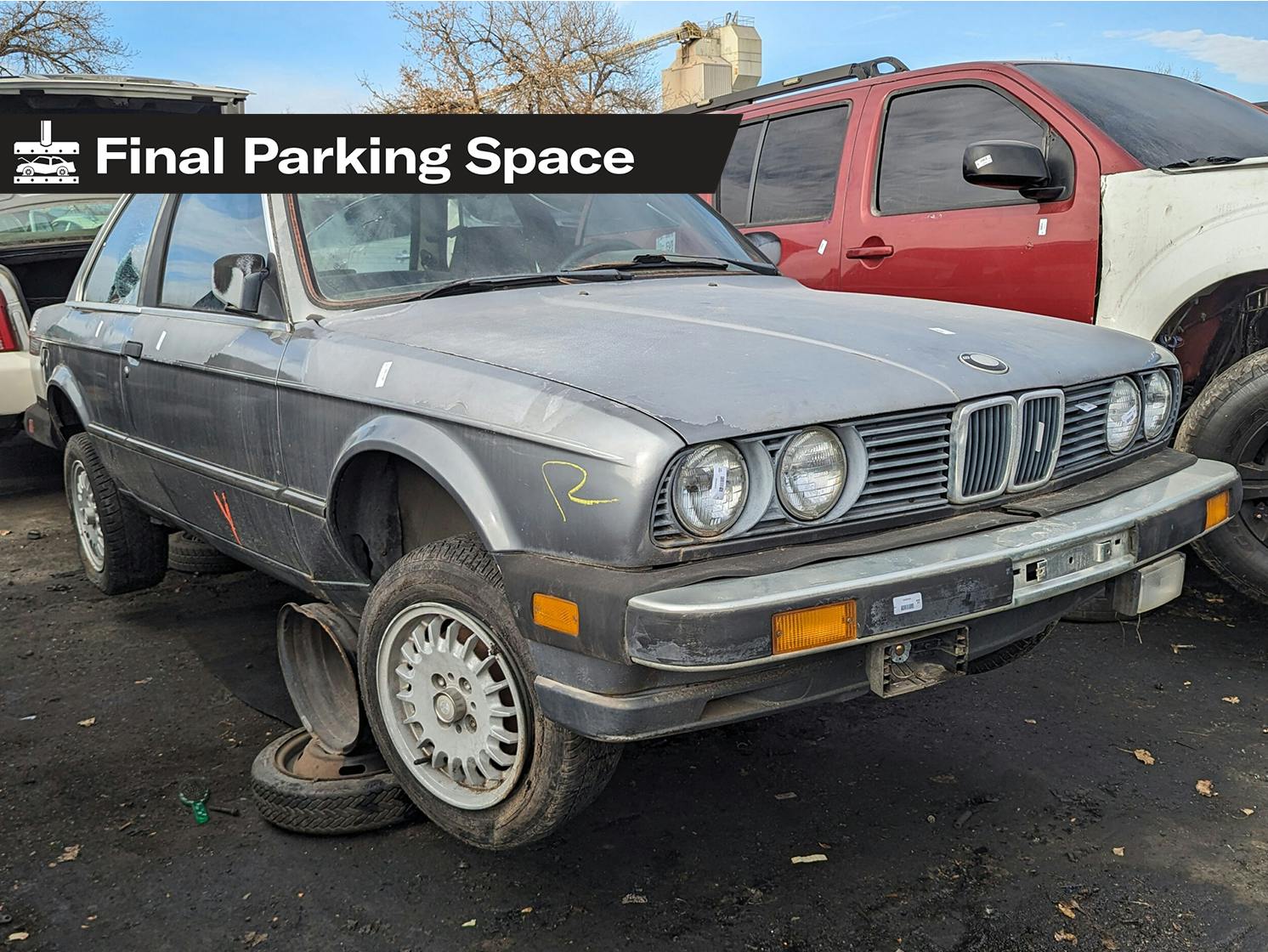Media | Articles
Final Parking Space: 1984 BMW 325e
The Bayerische Motoren Werke company has been building the 3 Series since the E21 was revealed to the world in 1975. Since that time, we’ve seen six more generations of the 3 Series, and the E21’s immediate successor stands as perhaps the most beloved and iconic BMW ever built. That car is the E30, sold in the United States from the 1984 through the 1991 model years. For today’s Final Parking Space, we have an early E30 with six-cylinder engine and manual transmission, found recently in a Denver-area boneyard.
The first E30 model to be sold in North America was the 318i, equipped with the same four-cylinder engine as its 320i predecessor. It arrived on our shores during the later months of 1983 and thus shared showroom space with the 320i for a while. The first six-cylinder E30 sold here was the 325e; this one rolled off the assembly line in April of 1984.
If this is the original engine—Colorado E30 owners tend to be a swap-crazed bunch, so that’s not certain—it’s a 2.7-liter SOHC unit rated at 121 horsepower and 170 pound-feet. The “e” in the car’s designation stands for the Greek letter η (Eta), used by engineers as the symbol to represent efficiency. BMW designed this engine to make plenty of torque, as a way to boost fuel economy. (The gas lines of the 1979 Oil Crisis were still painfully recent memories at the time.)
The 325e was respectably quick off the line thanks to all that torque, but E30 enthusiasts tend to prefer the greater horsepower output of the non-Eta straight-six engines, which first appeared in U.S.-market E30s under the hoods of the 1987 325i and 325iS. As a wise and fair official with the 24 Hours of Lemons race series since 2008, I’ve seen hundreds of E30s going all-out on road courses around the country and can say that the 325e can keep up with the 325i just fine in the real world, though both types frequently suffer from maddening electrical-system problems, particularly those involving engine computers, on the race track.
A dismaying number of E30s were sold in the United States with the optional automatic transmission, which would have been a four-speed slushbox in an ’84 325e, but this car has the base five-speed manual. By the time you read this, the entire powertrain will likely have been yanked from this car by local BMW enthusiasts, who circle Front Range junkyards like vultures, hungry for E30 parts.
Marketplace
Buy and sell classics with confidence
There’s a lot of other good stuff here for the junkyard shopper, including wheels, glass, trim, door panels, and body parts. Contrary to the popular belief that even the roughest E30s are worth ten grand, cheap examples are still out there and some still show up at self-service car graveyards. True, discarded E30s are much less commonplace than they were a decade ago (these days, junkyard E46s are a dime-a-dozen and even E36s are still fairly easy to find at your local Ewe Pullet–type establishment), but I still find good ones during my junkyard travels.
The MSRP for this car was $24,565, or about $74,021 in 2023 dollars. If that seems steep, the four-banger 1984 318i listed at just $16,430 ($49,508 in today’s money) and it offered nimbler handling due to being nearly 300 pounds lighter. Meanwhile, Mercedes-Benz would sell you a new 190E 2.3 with five-on-the-floor and nearly as much power as the 325e for $22,850 ($68,853 now), while brave American car shoppers could buy a new 1984 Alfa Romeo GTV-6 coupe with a screaming 154-horse V-6 for only $19,000 ($57,252 today).
Air conditioning and a trip computer were standard equipment in the 1984 318i and 325e, along with an AM/FM/cassette radio, which has been replaced by a more modern aftermarket Sony unit.
What’s the lesson here? Use genuine BMW parts and don’t give up on your E30 dreams if you’ve always wanted one, because the price of admission may not be as high as you think.
















































Sorry I have seen few used junk BMW worth $10K. Most of these cars are great for the first 100K miles then after that many German cars become money pits.
I see the same with Aston Martins too.
Parts are expensive and not always easy to replace. My buddy buys up BMW that many give up on get them running and resells them for a profit. Most are given up on as the repairs cost more than the car.
He is working on a BMW for himself. It is getting a LS Chevy installed. He wants a reliable car.
That driver seat has morphed into another form of matter
It was once a nice car. Sad to see it like it is.
Looks like this one was consigned to the graveyard before its time–the eta engines especially were bulletproof, many going 300000 + miles without an overhaul due to their relatively low redline: 4800 rpm.
I drove an ’87 325e two door for ten years (2001-2011), the same color as this one: Delphin Grau. Bought for $1700 with 120k on the odometer. It was my daily driver/winter car (too nice to be called a beater). While that eta engine was denigrated by many, I learned to like it for its low end grunt. It would pull smoothly from 1200 rpm in 5th, despite a 2.87 differential, and return 30 mpg on the highway. I had very few mechanical problems (or electronic, for that matter) during my ownership, and the only rust that appeared was on the leading edge of the rear wheel openings. The clearcoat started to turn into powder, so as it did, I scraped away the clearcoat remains, thus having a “frosted” finish years before the car makers introduced it.
It thoroughly hooked me on E30s, so when I had an opportunity to snap up a nice 318is (“the 2002 of the 90s”), I did. Sold the 87–in two days–for what I paid for it, after ten years and 20k miles of faithful use.
Oh my….I own an ’87 325is and it makes me sad to see a rust free coupe in the bone yard. There are many desirable parts on this car for sure. Hyperv6 is certainly correct in predicting that a restored or refurbished E30 will put the owner in deeper than the value of the car. I can attest to that. I have waaay more in my car than it would sell for. But a well maintained 3+ or 2- E30 coupe is a beautiful thing to behold. A good looking car that’s a joy to drive. Not always fun to work on, however, but usually home mechanic friendly. Almost all BMWs made after the E30 became heavy and overly complex. This may be the last true Ultimate Driving Machine.
I bought a new US-spec 1985 325e (manual transmission, of course) from the local BMW dealer in Bayreuth, Germany as a newly minted Army captain right before rotating back to the States. It was a sweet car and great fun to drive. I definitely benefited from the outstanding Dollar:Mark exchange rate at the time of purchase, saving many thousands off the MSRP. In fact, after driving it for just under five years I sold it for what I bought it for. I recently rented a new BMW 330 for several days while on a trip to the Dallas area. I hated that car as much as I loved my old 325. The 330 was soulless, with idiotic instrumentation and non-intuitive/non-user friendly controls. Even after so many years and “refinements” in the interim, I’d greatly prefer to drive the former over the latter.